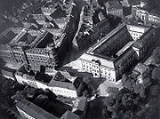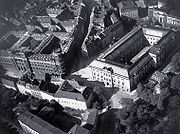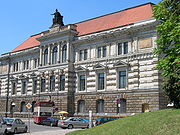
Albertinum
Encyclopedia
The Albertinum is a famous fine art museum in Dresden
, Germany
, close to Brühl's Terrace
and the Zwinger
.

, was built between 1884 and 1887 by Carl Adolf Canzler on the site of a former armoury to serve as a public museum
and archive. Since 1889 the Albertinum has displayed an excellent sculpture collection, including the celebrated but problematic reconstructions of the Lemnian Athena
. Destroyed in February 1945, the Albertinum was rebuilt by 1953.
Until 2004 the Albertinum was the postwar home of the Green Vault (Grünes Gewölbe), often called Germany's most meaningful collection of royal treasures, such as a cherry pit with 365 engraved faces. However the Green Vault is now back in the innercity Residence castle in Dresden
and no longer in the Albertinum. Regarding new masters, sometimes the students of the Dresden art academy show their works of future masters, or not, in front of the Albertinum.
 Today it hosts the Gemäldegalerie Neue Meister (New Masters Gallery) and the Münzkabinett
Today it hosts the Gemäldegalerie Neue Meister (New Masters Gallery) and the Münzkabinett
(Coin Cabinet) of the Dresden State Art Collections (Staatliche Kunstsammlungen Dresden
) but is currently under construction. The New Masters Gallery features masterpieces from the 19th and 20th century including works by Degas, Dix, Manet, Monet, Richter, Van Gogh, and others.
In 2006 the Albertinum was closed due renovation. It was finally reopened on the 20th June 2010 as a "house of the modern" with the New Masters Gallery and parts of the sculpture collection in a brand new conception. The most important improvement has been the roofing of the inner courtyard to an atrium, called "an ark for the art". The reason for the necessity of renovation was the "one-hundred-year flood" of the river Elbe
in 2002.
Dresden
Dresden is the capital city of the Free State of Saxony in Germany. It is situated in a valley on the River Elbe, near the Czech border. The Dresden conurbation is part of the Saxon Triangle metropolitan area....
, Germany
Germany
Germany , officially the Federal Republic of Germany , is a federal parliamentary republic in Europe. The country consists of 16 states while the capital and largest city is Berlin. Germany covers an area of 357,021 km2 and has a largely temperate seasonal climate...
, close to Brühl's Terrace
Brühl's Terrace
Brühl's Terrace is a historic architectural ensemble in Dresden, Germany. Nicknamed "The Balcony of Europe", the terrace stretches high above the shore of the river Elbe in a city which is quite large as measured by area relative to its half a million inhabitants...
and the Zwinger
Zwinger
The Zwinger is a palace in Dresden, eastern Germany, built in Baroque style. It served as the orangery, exhibition gallery and festival arena of the Dresden Court....
.

History
The Albertinum, named after Saxon king AlbertAlbert of Saxony
Albert of Saxony may refer to:* Albert of Saxony * Albert I, Duke of Saxony * Albert, Duke of Saxony * Prince Albert of Saxony, Duke of Teschen * Albert of Saxony...
, was built between 1884 and 1887 by Carl Adolf Canzler on the site of a former armoury to serve as a public museum
Museum
A museum is an institution that cares for a collection of artifacts and other objects of scientific, artistic, cultural, or historical importance and makes them available for public viewing through exhibits that may be permanent or temporary. Most large museums are located in major cities...
and archive. Since 1889 the Albertinum has displayed an excellent sculpture collection, including the celebrated but problematic reconstructions of the Lemnian Athena
Lemnian Athena
The Lemnian Athena or Athena Lemnia, was a classical Greek statue of the goddess Athena. According to Pausanias , the original bronze was created by Phidias circa 450-440 BCE, for Athenians living on Lemnos to dedicate on the Acropolis in Athens, Greece.It is unclear whether any copies remain...
. Destroyed in February 1945, the Albertinum was rebuilt by 1953.
Until 2004 the Albertinum was the postwar home of the Green Vault (Grünes Gewölbe), often called Germany's most meaningful collection of royal treasures, such as a cherry pit with 365 engraved faces. However the Green Vault is now back in the innercity Residence castle in Dresden
Dresden
Dresden is the capital city of the Free State of Saxony in Germany. It is situated in a valley on the River Elbe, near the Czech border. The Dresden conurbation is part of the Saxon Triangle metropolitan area....
and no longer in the Albertinum. Regarding new masters, sometimes the students of the Dresden art academy show their works of future masters, or not, in front of the Albertinum.
Today

Münzkabinett
The Münzkabinett is part of the Staatliche Kunstsammlungen Dresden , Germany. Founded around 1530, it is one of the oldest museums in Dresden. It is located in the Dresden Castle....
(Coin Cabinet) of the Dresden State Art Collections (Staatliche Kunstsammlungen Dresden
Staatliche Kunstsammlungen Dresden
Staatliche Kunstsammlungen Dresden is a cultural institution in Dresden, Germany, owned by the State of Saxony. It belongs to the most renowned and oldest museum institutions in the world, originating from the collections of the Saxon electors in the 16th century .Today, the Dresden State Art...
) but is currently under construction. The New Masters Gallery features masterpieces from the 19th and 20th century including works by Degas, Dix, Manet, Monet, Richter, Van Gogh, and others.
In 2006 the Albertinum was closed due renovation. It was finally reopened on the 20th June 2010 as a "house of the modern" with the New Masters Gallery and parts of the sculpture collection in a brand new conception. The most important improvement has been the roofing of the inner courtyard to an atrium, called "an ark for the art". The reason for the necessity of renovation was the "one-hundred-year flood" of the river Elbe
Elbe
The Elbe is one of the major rivers of Central Europe. It rises in the Krkonoše Mountains of the northwestern Czech Republic before traversing much of Bohemia , then Germany and flowing into the North Sea at Cuxhaven, 110 km northwest of Hamburg...
in 2002.

